In an attempt to be Catheresque for a moment (if I dare), here is the soil out of which grew the struggles, many of which were fed by the experience of abject poverty and later, scraping-by working class, as well as a family habit of stoicism and silence. Farming is not my immediate heritage--my grandfather worked in a foundry until he lost an eye in an accident--but, according to family stories, when the two Irish branches of the family ventured west, they took up land. That's pretty much all I know. That, and I think I had a great-great-grandmother who was a teacher in either northern Nebraska or in South Dakota. More prairie to see in the next three days...
Saturday, July 28, 2007
A Dose of Prairie
In an attempt to be Catheresque for a moment (if I dare), here is the soil out of which grew the struggles, many of which were fed by the experience of abject poverty and later, scraping-by working class, as well as a family habit of stoicism and silence. Farming is not my immediate heritage--my grandfather worked in a foundry until he lost an eye in an accident--but, according to family stories, when the two Irish branches of the family ventured west, they took up land. That's pretty much all I know. That, and I think I had a great-great-grandmother who was a teacher in either northern Nebraska or in South Dakota. More prairie to see in the next three days...
Friday, July 27, 2007
Final Thoughts from Wash U.
Lyricist Andy Razaf on “Ain’t Misbehavin,” 1929: “[Fats] worked on it for 45 minutes and there it was.” (source: http://www.jazzstandards.com/)
In the HBO film Boycott, the character Bayard Rustin compares the political implications of the 1955 Montgomery Bus Boycott to “jazz” as a way to give the act meaning, a contextual significance, to turn it into a movement. If I were to write a different kind of essay to unpack and support this comparison, no doubt I would find that this particular moment in time did indeed possess rhythm (or, a foundational coherence, a logic, a reason), improvisation (or, spontaneity, intuition, freedom, confidence), and call and response (or, collaboration, cooperation, thesis and antithesis, innovation). Aren’t these basics necessary for change of any kind? These are the tools for cause and the outcome, or effect, is what Dr. O’Meally called “a thick slice of culture.” At any given moment, painters, writers, historians, journalists, politicians, philosophers, musicians, and ordinary citizens are in a jam session creating that “thick slice of culture.” And yes, sometimes, it’s a slice of filet mignon, and sometimes, it’s, well, meatloaf. Walt Whitman, an ur-jazz poet of sorts, claims America is its own greatest poem, that collectively, it is free verse, pushing at its boundaries, and constantly, to rework Ralph Ellison (and Professor Herman Beavers), losing its identity as it is finding it.
To be more concrete: What if, in late August, I begin my American Literature class with jazz, the music? What if I started the first day, without any front-loading, playing a sampling of Armstrong, Parker, or Coltrane? Williams, Bryant, or Fitzgerald? Would a basic jazz vocabulary, and the music, give students an interesting path into Frederick Douglass’s Narrative, our first major text of the year? Would this approach help students access their voices, the logic, and originality in their writing? Would hearing a call and response between the piano playing styles of James P. Johnson and Fats Waller, between the renditions of “Summertime” by Ellington and Greg Osby, help forge a classroom community of learners? Learners who ask questions, practice, explore, take risks? Is “call and response” how I want them to think about my comments on their drafts and about me as a teacher of writing? If using art in the English classroom helps students hone their analytical and conceptual skills, will layering art and literature with jazz really bring it home? Or somehow make it more meaningful? Or, heaven forbid, more fun?
These questions reflect the big thinker in me; as teachers, we don’t often have the time during the academic year to ask the big questions, to ponder significant and meaningful change in curriculum, so the luxury of the Institute for me has been the opportunity to consider them. While my inner optimist lives strong, particularly in late July, a reality check may prevail and my ambitions may be reduced to a curricular unit or two. At least for this coming year, for example, upon arriving at the moment in which the paintings of Aaron Douglas and Jacob Lawrence provide an interesting and useful pairing with Locke, Hughes, and Hurston, I can thicken the slice of culture by challenging them with Ellington’s “Black and Tan Fantasy,” and “East St. Louis Toodle-oo,” Waller’s “African Ripples,” and “The Joint is Jumpin.” Using creative vehicles, giving them a jazz vocabulary would also mean a set of “jazz culture” questions that could lead us into discussions of race, power, gender, identity, and whatever else the students come up with that I can’t ever anticipate.
I leave with many questions and many temptations to experiment, take risks over and above the routine I’ve established in nineteen years of teaching. I am hoping that my own ongoing processing of, and response to, the material, lectures, and people I’ve encountered here at this Institute will continue to sit here inside allowing me to piece together some kind of theme and variation, with a blue note here and there. Now, being the neophyte that I am, I need to retreat to the woodshed and work on the swing within.
July 27, 2007
Wednesday, July 25, 2007
Some thoughts about cost...
"'...it's what goes on in the world that reconciles me.'" --Alexandra, in Cather's O Pioneers!
And there it is. Nerve central. The twist. The implications of Alexandra's sense of belonging and her will to stay put and rely on the natural swing of things, and believing that, as her instincts tell her, the outcome is benevolent. No matter how strong the sense of belonging, there are always forces within seeking to destabilize. It is the nature of our psyches, I suppose. But it's not just a reliance on fate, or natural cycles, or the inevitable ebbs and flows. There is a necessity to open up, look, listen to all aspects of the external world in order to unify, make compatible again, all aspects of self. A professor of note recently asked a provocative question in relation to negotiating all kinds of tight spaces in order to achieve some semblance of identity: What will it cost you to be you? It certainly costs Alexandra, partly blanketing her Eden with violence, misunderstanding, and blood. The loss of her brother, a soul mate, a sibling-son, does force her to enter the outer world on her own, instead of relying on his tales, his narratives. She can now create her own and see for herself. Her recognition of the world has always been there, but now it's her lens through which she filters it, not Emil's, even though he will remain part of her frame of reference; I still think the reconciliations should be even more fulfilling.
What will it cost you to be you? You can't always name your price and you may know it's expensive, but it is inevitable; however, being aware of the cost can put you in control. Being mindful can be reconciling and this is where I'm at. Perhaps it was the feeling of reconciliation that made me feel I was falling into Homer's painting, or Tanner's painting. Something about both, as different as they were, made me feel at home.
Tuesday, July 24, 2007
Museum Meanderings
Sunday, July 22, 2007
To the Ozarks
Friday, July 20, 2007
12-Bar Rest
Idle instruments are awkward and beautiful at the same time. Devoid of life, but full of possibility. Yesterday, I had the unique opportunity to hear both in the afternoon and in the evening, Satoko Fuji and Natsuki Tamura (pianist and trumpeter, respectively). In the afternoon, we gathered for a q & a and Tamura's trumpet lay casually and provocatively on the padded piano bench. It waited. There, it is a vessel, an ornament, particularly mysterious and romantic to those of us who do not play an instrument. Prior to the Red Holloway set last week here in St. Louis, his alto sax and the bass waited, too. Atilt and horizontal. Not the positions they were meant for, but forced momentarily into sleep. I've noticed that when the musicians pick up their instruments, the sax, the trumpet, the bass, simultaneously become dynamic in their own right (perhaps this is my own anticipation that perceives this) and become a true extension of the musician's body--as if the musician would fall dead if that instrument were taken away, lopped off, or extricated from the grasp. In the hands of Tamura, the trumpet was him, his voice and vocal cords, organically linked. Intrinsic. Last Sunday, at Graceland, an acoustic guitar was propped up in a chair in the 'jungle room," looking far more awkward and lifeless than the glossy grand piano in the front room framed by stained-glass peacocks.
Tuesday, July 17, 2007
Carniverous Meanderings
Nothin' like gnawin' on pork ribs to make one get in touch with the primal. To my civilized sensibility, it just seems wrong to be scraping teeth on bone, tearing, pulling, getting remnants of it all under the fingernails. I have to say, however, once I first chomped, I felt the urge to growl every time someone walked by to let them know that this rib was mine and not theirs. Of course, in getting in touch with the primal, chomping on great ribs is far more satisfying than any holler-inducing drum circle. Hence my stop at Rendezvous in Memphis for a late lunch/early dinner after a recommendation by someone here in St. Louis who frequents Memphis "because it's so close." Entering the restaurant via a back alley where it seems to share the entrance with all deliveries gives the impression of stepping into a speakeasy and I willingly went along with this evocation since I seemed to be surrounded by the right architecture. And I had Ellington and Bessie Smith in my head. Once they slide the ribs in a red plastic basket in front of you, the speakeasy theme fades away. No, this is not a restaurant review and I'm not in the habit of talking about my meals. I had recently finished Cormac McCarthy's Cities on the Plain, the third novel in his Border Trilogy. Never having been a fan of the western (film--with some exceptions--or novel) or never having been attracted in any shape or form to the cowboy myth (or the cowboy for that matter), I was surprised to find myself taken by both the main characters and by McCarthy's poetic descriptions of landscape. Like gnawing on ribs, reading these novels tapped into the visceral, the primal, the liminal space in which humanity and bestial meet. The ruthlessness of both man and nature is a constant challenge, and when battles are lost, what is left is a good amount of desolation, loneliness, and disconnection. And, of course, death and destruction. John Grady Cole's final face-off with evil incarnate near the end of Cities is a twist on the high-noon, ok corral sort of duel--more frightening if not more apocalyptic, and resulting in a more heartwrenching ending. Very sad, and very dark. There is a moral center--thank goodness--but its survival in the end is tenuous at best.
I still think John Grady Cole, and his counterpart, Billy Parham, should get together in a story with Huck Finn. I'd say Holden Caufield, too, but I think all three would become exasperated enough with him that they would end up slapping him around (and he'd deserve it). Boot him out by the end of chapter 1. Feeling a deep connection to McCarthy's characters, something about eating mighty fine pork ribs in a dim basement in Memphis that made me think I could hunker down at a campfire and chomp on some freshly killed and freshly skinned furry animal. Ok, that was a fleeting thought and one that disappeared completely when the waiter scooped away the red plastic basket containing the remains of some deceased pig. My civilized sensibility, such as it is, quickly restored itself and then, after crawling up out of the basement and back into the sunlit, smoky alley, I was on the hunt for some ice cream.
Monday, July 16, 2007
Two Kings, an Aristocrat & All That Jazz...
Tuesday, July 10, 2007
Rest Stop
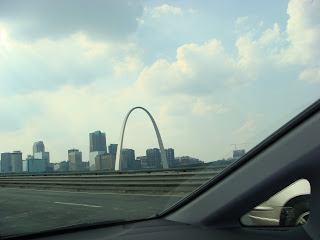
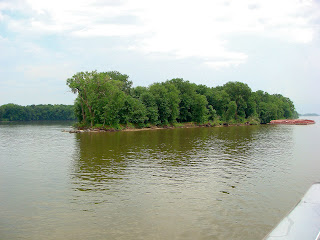
Sunday, July 8, 2007
Ellington, Baseball, and Koalas
 "For this world also which seems to us a thing of stone and flower and blood is not a thing at all but is a tale. And all in it is a tale and each tale the sum of all lesser tales and yet these also are the selfsame tale and contain as well all else within them. So everything is necessary. Every least thing." --Cormac McCarthy, The Crossing.
"For this world also which seems to us a thing of stone and flower and blood is not a thing at all but is a tale. And all in it is a tale and each tale the sum of all lesser tales and yet these also are the selfsame tale and contain as well all else within them. So everything is necessary. Every least thing." --Cormac McCarthy, The Crossing. 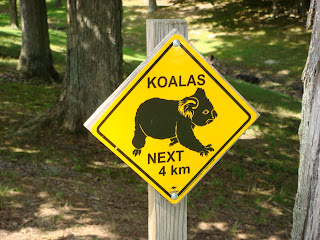 About 60 miles east of St. Louis off the I-70 lies Mulberry Grove, amid corn and soybean fields, stores full of farm equipment, WalMart, and funny little signs at a campground that pay homage to Down Under. These signs have a story of their own, not to mention possess the story of the proprietor--my friend BG--and her own tale of an epic journey.
About 60 miles east of St. Louis off the I-70 lies Mulberry Grove, amid corn and soybean fields, stores full of farm equipment, WalMart, and funny little signs at a campground that pay homage to Down Under. These signs have a story of their own, not to mention possess the story of the proprietor--my friend BG--and her own tale of an epic journey.Friday, July 6, 2007
4th of July 2007

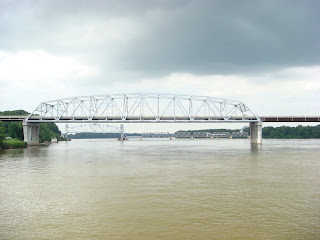
Back in Business
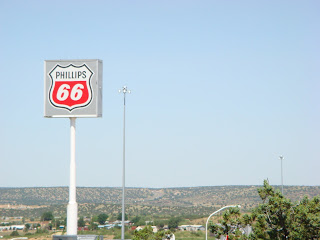
near Santa Rosa, NM
east of Amarillo, TX
(Internet access difficulties in the past few days)
Saturday, June 30
Logged: 696.5 miles
Sunday, July 1
Logged: 504 miles
Cheapest gas thus far: $2.77 in Mt. Vernon, Missouri.
A few favorite highway signs:
“Wind Gusts May Exist” (New Mexico): This really means: you drive at your own risk; if there is a gust that appears out of nowhere and sweeps you off the highway forcing you to plunge to your death, we take no responsibility. Hey, we warned you!
“Severe Crosswinds”: In Texas. This would not have captured my attention except in comparison to the above. No tentative approach here, just direct. Of course, I’m wondering why there were no signs about the powerful stench when passing a huge cattle yard. It seems to me this was more dangerous than any nonexistent crosswind. How about: “Severe odor for next 2 miles. Proceed with caution.”
Oh, and one more…
“Do Not Drive Into Smoke”: I’m not even sure what this means, but it made several appearances on the I40 and I44 of Oklahoma.
Ooh, wait, one more highway oddity: the Adult Superstore. Right off the highway, like a McDonalds or a Love’s Travel Stop. Big sign reading “Adult Video” right along side of a souvenir shop called “Calico Country.” The gigantic, anticipatory billboards advertising, “Adult Superstore 15 miles ahead Exit 38,” just like the billboard advertising a drive-thru Animal Paradise (petting zoo, ice cream, etc.), a must see for the whole family, Exit NOW. Even truckers get lonely? I thought that’s what a CB was for. Or are Ma and Pa tired of watching the Disney DVDs in the minivan? Somethin’ for everyone on the road, I s'pose.
On a more reflective note…
Walt Whitman. Woody Guthrie. How does anyone wrap up such varied landscape into a single lyric? Varied, even over only four states, driving only two interstates. I have not, until now, driven east of Albuquerque (be assured, I have traveled, but only by air), so I was rather taken with the beauty of eastern New Mexico, northern Texas, and Oklahoma. My trusty road atlas informs me of the right highway, allows me to estimate distance, and gives me the name of every small speck of a town between more well known ports of call. But it doesn’t indicate terrain; the road atlas says nothing of the landscape. It doesn’t tell me “gorgeous scenic view of New Mexican plains, verdant in summer, low rolling hills of coniferous shrubs, perfect for that Kodak moment, especially if there are spots of pillow clouds hanging oh so gracefully in the sky.” No glossing for the Texas prairie, or for the huge sky that wraps around the earth, or for the wildflowers that give a sunny shimmery sheen to the pale green prairie grass. No endnotes about the hills and near-New England green of Oklahoma. Why is it that the only image I had of Oklahoma was of the dusty land of the 1930s? The dramatic shift to the Ozarks in Missouri did not go unnoticed, but my romantic vision of landscape was put on hold when I found myself in the middle of a rainstorm and trying to avoid the fearless truckers who could care less about the waves of water their giant tires can spew on to the vehicles directly behind them, reducing visibility even more and increasing the likelihood of hydroplaning. I learned quickly to take advantage of the uphill grades which my Honda climbed effortlessly, making it possible for me to pass any semi through its watery wake with only a few seconds of lost visual contact with whatever was outside my windshield—advantage: me.
I can’t begin to do the scenery justice without treacle or cliché, both crimes I’ve committed above. It does, however, remind me of Whitman and Guthrie who were able to poetically, and memorably, catalogue the vastness and illustrate their admiration (even if one assumed a democratic right to the landscape and the other had to demand this right) for all of the possibilities and opportunities this varied landscape promised. And they both did so also reminding us of the cost to others. I couldn’t help but think about this as well every time I passed a sign informing me I was driving through, or leaving, one of several Indian reservations.
